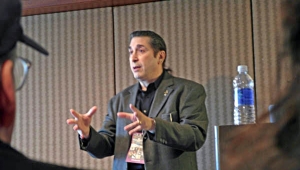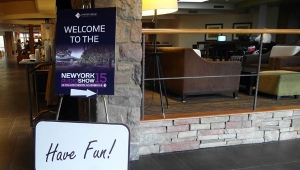| Columns Retired Columns & Blogs |
The New York Audio Show: Finis
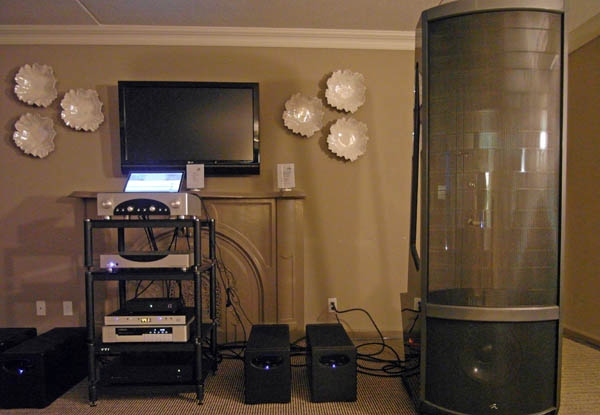
The word flagship takes on new meaning when the product in question is literally the size of a small boat; so it is with MartinLogan's 75"-tall, 385lb Neolith loudspeaker ($79,995/pair), which combines electrostatic and dynamic transducers in a high-tech phenolic frame. Appropriately enough, the Neolith's appearance at the Rye Brook Hilton took place in one of the two largest rooms reserved for the New York show. (One day after the show, I'm still not sure if those are sound-enhancing accessories, objets d'art, or dinner plates on the wall behind the Neoliths: There exist some questions that even the bravest reviewers are too squeamish to ask.)
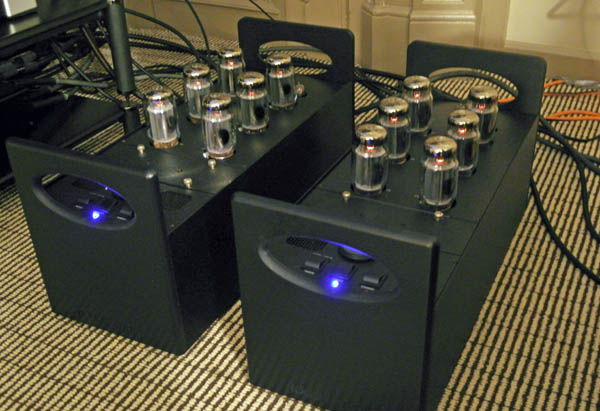
Driving the MartinLogan Neoliths were a quartet of Rogue Audio power amplifiers new to the consumer marketplace—although, according to company founder Mark O'Brien, a few pairs of Rogue Apollo Dark monoblock amps ($14,995/pair) have already been sold to audio-industry colleagues. When I visited the Rogue Audio/MartinLogan suite, a high-resolution file of modern and somewhat techie pop music (yes, I know how old that description makes me sound) was tight, powerful, and resplendent with detail without seeming bright.
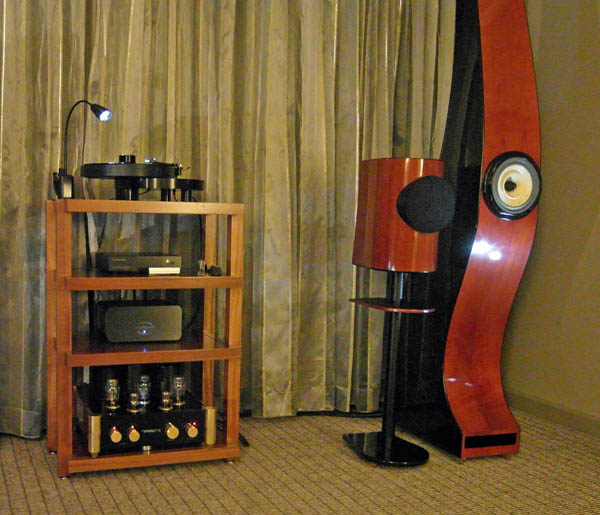
I wrote about the Teresonic Integrum—a quarter-wave-pipe-loaded loudspeaker designed around a Lowther full-range driver—back in Stereophile's February 2007 issue, but never had the chance to meet its designer, Mike Zivkovic. That opportunity presented itself at the New York show, where Mike demonstrated Teresonic's newer Integrum XR loudspeakers ($19,985/pair), driven by the company's own Reference 2A3 integrated amp ($15,000) and an AMG Giro turntable with 9W2 tonearm ($9900 for the combo) and Teatro cartridge ($2750), with various Teresonic cables. In recent years I've moved away from the Lowther approach, which offers much to the hobbyist who's willing to live with that driver's idiosyncrasies—yet other music lovers have pitched camp and stayed there forever. Adventurous souls in search of an impactful loudspeaker will find Mike Zivkovic to be a Lowther specialist of insight and integrity.
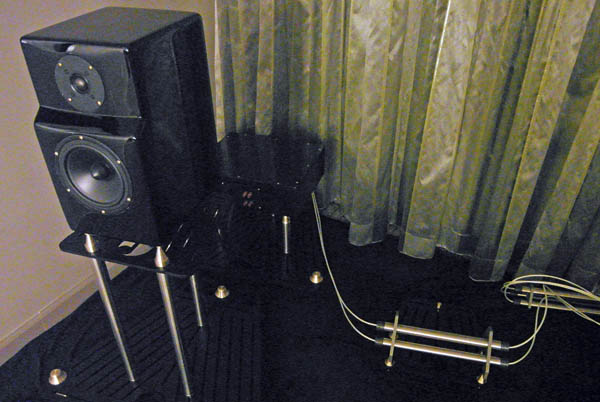
The room sponsored by Star Sound Technologies of Allentown, PA was so dark, I'm surprised my photo of their system was usable. (Admittedly, I'm shocked whenever any of my photos come out okay.) The folks running the dem were very nice—and very candid on the point that, with the exception of their Wadia CD player, pretty much everything on display was not yet in production. Those products included a stand-mounted loudspeaker called the Caravelle ($8000/pair estimated) and a prototype amplifier about which no information was offered. Pity: Even though I don't usually gravitate toward CD sources and solid-state electronics, I thought the sound was excellent: Leading edges of notes were slightly, realistically rounded, and there was plenty of color and musical drive. Of course that may also have been influenced by Star Sound's use of interconnects and speaker cables from High Fidelity Cables, whose display was in the adjoining room . . .
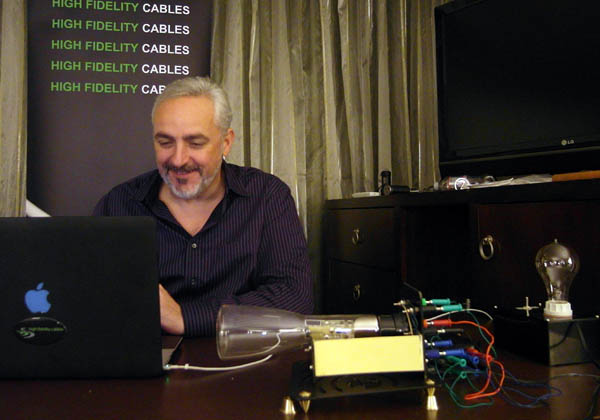
Upon entering the High Fidelity Cables room I remembered that my friend Tom Krauss—former Listener contributor and now proprietor of Audio Loft LLC—had enthused over this brand when I ran into him on the first day of the show. High Fidelity's calling card is, in essence, a magnetic cable—or, to put it more concisely, a cable that uses the focused application of magnetism to overcome skin effect and enhance signal propagation. Rick Schultz, the developer of this technology, used illustrations, animations, mathematical formulas, and an actual cathode-ray tube to illustrate his ideas; I am an unapologetic cable-technology skeptic—yet I think that Schultz is on to something here.
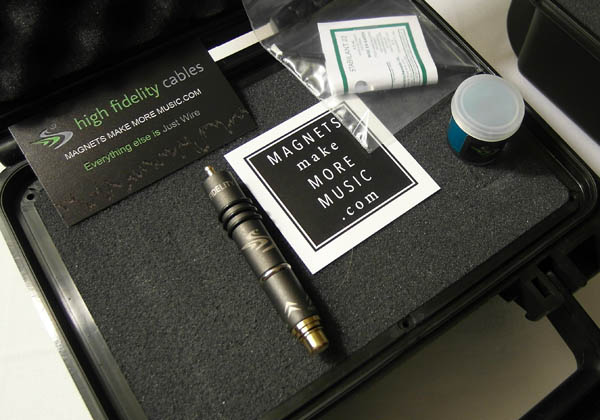
My very real enthusiasm was tempered somewhat by High Fidelity's pricing structure, which creeps into the five-figure zone—although, for once, there's more than senseless bulk or hermetically sealed magic boxes to justify those numbers. Luckily, there's a starter kit of sorts: For $299, High Fidelity sells a Magnetic Adapter Kit that works in line with one's existing cables and, reportedly, improves their performance. I'm just about ready to request a review sample. Just. About. Ready.
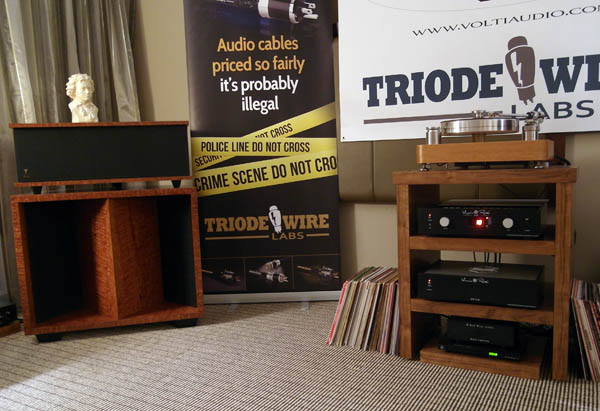
My last stop on Saturday was the room shared by Volti Audio, Vinnie Rossi Audio, and Triode Wire Labs. This nicely balanced system paired a Palmer Audio turntable/tonearm and Dynavector cartridge with a Vinnie Rossi LIO integrated amplifier that was being used as a preamplifier only ($6775 as equipped—but a full description of Rossi's pricing structure would require more space than is available to me). Amplification honors fell to the new Vinnie Rossi VR120 stereo power amp ($4995), which uses the same ultracapacitor-isolated, twin-bank MOSFET output technology as the Rossi integrated. All cabling was by Triode Wire Labs, and included their new Spirit "75" digital interconnect ($299), which promises true 75 Ohm performance. (It's worth noting that all of TWL's cables are similarly affordable—and that's a beautiful thing.) The loudspeakers were Volti's perennially recommendable Vittora horns ($21,500/pair without Extended Low Frequency module, $25,000 with) in a gorgeous quilted bubinga veneer.
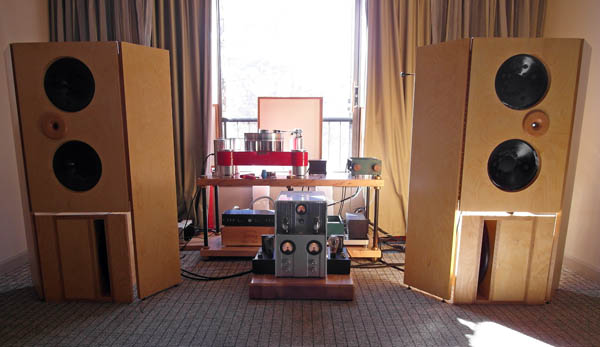
I closed my eyes for what seemed like two seconds, and poof—it was Sunday! So I set about visiting the six systems I had yet to see and hear, beginning with the room sponsored Bill Demars of the upstate-New York dealer/distributor Beauty of Sound. This system had as its source a beautiful, bright-red Tourbillon turntable ($19,500) fitted with a 12" Ikeda IT-407 tonearm ($6500), itself driving a TubeGuru Reference Phono Stage ($7500) and, from the Portland, OR-based company Whammerdyne Heavy Industries (oh, dear), a 2A3-based stereo amplifier called the Truth. Loudspeakers were a Demars-built pair of Bastanis Mandalas fitted with "wings" for additional upper-bass reinforcement (approximately $12,500/pair finished), and cables were by Extreme Audio. The coolest part: The phono cartridge selected for this distinguished system was a simple Denon 103 ($230 street price), which endures as perhaps the highest-value product in audio. The system, like the view outside on that distinctly pretty morning, was colorful, clear, open, and very inviting: the sort I could easily live with.
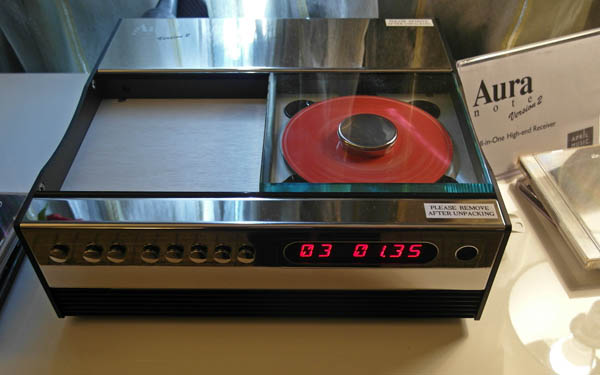
On display in the April Music room was the Aura Note v.2 combination CD player/DAC/FM tuner/125Wpc integrated amplifier ($2500), driving a pair of Focus Audio FC6 SE stand-mounted loudspeakers ($CDN1500/pair) with the aid of Veristar Grand Illusion speaker cables ($1700/pair approximate). At this New York demonstration, I had much the same experience as in Montreal, at a recent Salon Son et Image (at which the original Aura Note drove a pair of small Dali loudspeakers): enchantingly colorful, involving music-making, with the sort of momentum, flow, and overall realism that I normally associate with analog sources and tubed electronics—really! Now as before, the experience bordered on the uncanny, and without taking away from the inherent qualities of the Focus Audio (or Dali) loudspeakers, I can't help thinking that the Aura Note v.2 is where this system's magic resides.
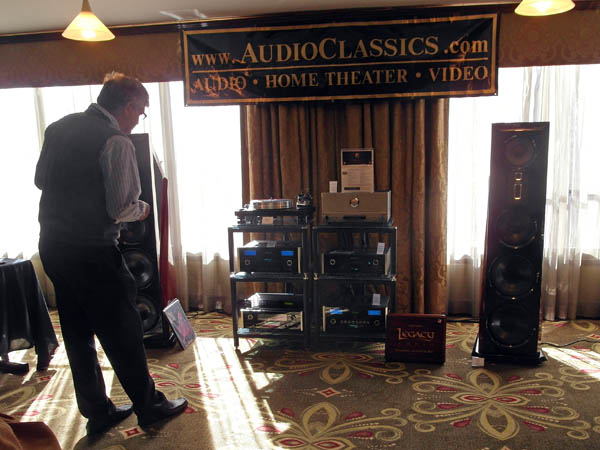
From there it was a brief walk to the large ballroom sponsored by my fellow upstate-ers at Audio Classics. From its humble beginnings selling vintage gear out of a shop in the basement of the Walton, New York Post Office—seriously!—Audio Classics has become one of the largest dealers for new electronics from McIntosh Labs, whose signature glass faceplates were plentiful in a dynamic-sounding system that also used a VPI Prime turntable ($3800), Audio Classics' own 9b stereo power amplifier ($8000 approximate), and Legacy Audio Aeris loudspeakers ($20,000/pair approximate).
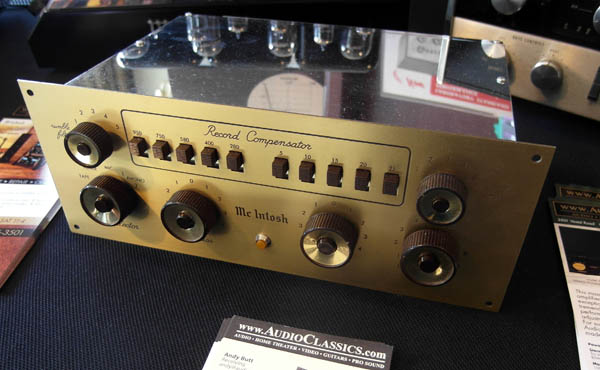
Audio Classics continues to recondition and sell used gear, many examples of which are truly of investment quality. A case in point: This 1950s-era C-8 phono preamp (with switchable EQ curves!) sold for $148 brand new. Today, this cleaner-than-clean sample is expected to fetch between $1500 and $2000.
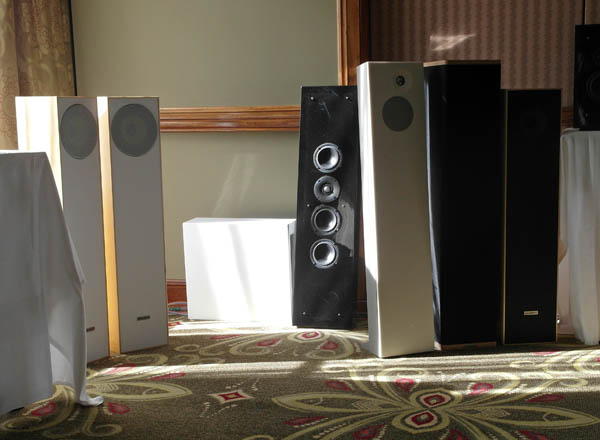
Tim Ryan of distributor/dealer SimpliFi Audio came all the way from San Diego, California with the latest in loudspeaker technology from central Europe and Scandinavia. (I think you can tell from the pic: These aren't American speakers!) Of special interest was the Swiss-made Klangwerk Phil loudspeaker ($6000/pair), which is the white one just to the right of center in this photograph. This slender floorstander, the baffle of which is crafted from artificial stone, can also be fastened directly to a wall; a clear-plastic waveguide on the tweeter maintains optimal dispersion, regardless of placement. (That said: With respect, I wonder if the SimpliFi demonstration might have been enhanced, in terms of both sound quality and the level of confusion over precisely what was being demonstrated at any given time, by having just one pair of loudspeakers at the front of the room.) Ryan also gave a very convincing demonstration of the benefits of DSPeaker's Anti-Mode 2.0 Dual Core room-correction hardware/software.
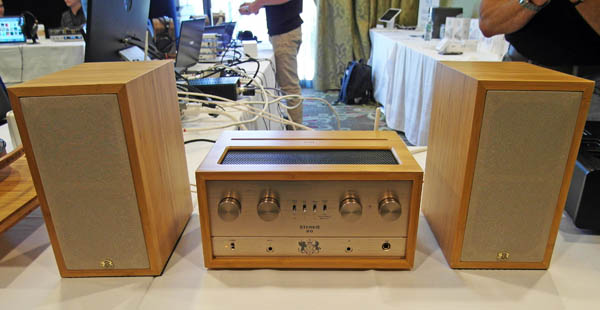
My last stop of the show was at the booth sponsored by iFi Audio, the UK-based design firm that seems to introduce interesting new products on an almost weekly basis. Of course, considerations of time, space, and fairness forced mean that I can post a photo of only one—and that's their recent Stereo 50 Reference System ($1995), which includes full-function internal versions of the company's iPhono phono preamp and iDAC2 D/A converter. The main unit also includes a 7W headphone amplifier and a velvet-lined slot in its bamboo casework—the latter a perfect resting place for one's iPhone or similar device.
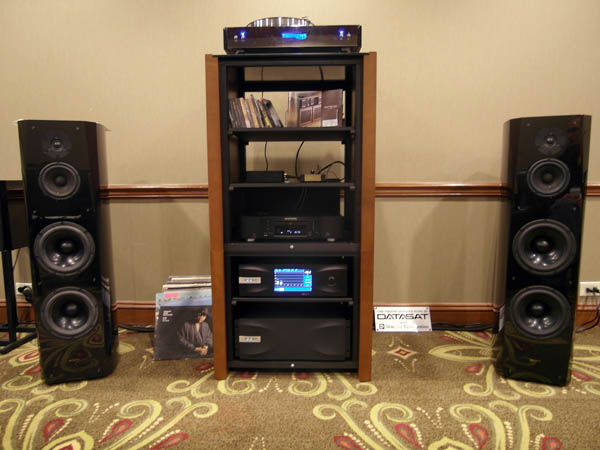
And finally: Near the end of the day on Friday, I visited the room sponsored by the Westchester County retailer Value Electronics, where I enjoyed a home-theater demonstration featuring Datasat and Sony gear (the film was the excellent Tom Cruise vehicle Edge of Tomorrow), and a two-channel system using gear from the same two firms. At the time, proprietor Robert Zohn didn't have detailed information of the specifics of latter system, but in a recent e-mail he suggested that the speaker was Sony's SS-AR1 ($27,000/pair). After a bit of digging, I determined that the turntable/tonearm combination was Thorens' TD-550 ($15,000 approximate) and the preamp-DAC was Datasat's RS201 ($20,000).
- Log in or register to post comments

